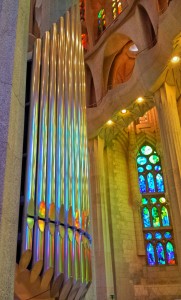By Bart Barry-

Editor’s note: For part 2, please click here.
*
MARFA, Texas – This city sits in a little known region of our country called “Big Bend” for the curve the Rio Grande takes. There is a national park that boasts Texas’ most challenging and beloved hiking trail to the top of the Chisos Mountains, but the basin of the Chisos is a 2 1/2 hour drive, despite being only three towns over. Texas is secluded or lonely, depending what one makes of solitude, and rugged.
Marfa is the town 20th century minimalist sculptor Donald Judd chose for the creation and display of his work. While he divided his time between Texas and New York, he prized the light and vastness of the American Southwest, and today Marfa is both a town and a Judd museum of sorts.
Donald Judd was more than indifferent to art museums; he was hostile to them. He recognized the de facto mediocrity of anything done by a committee, an arrangement in which, by definition, consensus is more important than quality – where the lowliest members win by filibuster, and the one or two talented members either acquiesce from exhaustion or resign immediately. Judd did not trust either the curatorial process, and he sure as hell did not trust the light in which his works would be displayed.
Judd’s academic work at Columbia University was in philosophy, not art, and his promiscuity of literary taste – he read both widely and deeply – gave him an iconoclastic bent not appreciated by the artistic community, which in its tastes and associations reliably followed and follows the academy’s definition for diversity: People who look different and think the same. Judd, contrarily, understood the scandalous diversity of unfettered human thought. He read in English, Spanish and German, one notes from the volumes on the pinewood shelves he had made for his library, and perhaps a dialect of sorts, too: Catalan.
There was in Mr. Judd’s library a disproportionate emphasis on Barcelona, City of Gaudi.
Judd wrote widely, more than 600 articles of artistic criticism, and made acquiantenceships and often friendships with his subjects. He called his own forays in painting “sophomoric” and soon abandoned the medium altogether, moving from painting’s illusion of three-dimensionality to the actual third dimension via mixed media and the minimalist sculptures for which he would gain recognition and celebrity and a fortune.
Judd was right not to trust museums. Seen in museums, held in isolation from their comrades, hung on a wall among complicated paintings or stood on a floor among other busy creations, Judd’s simple shapes and flawless lines can look ironic, lazy and dull. Seen within edifices he selected for their light and spatial properties, seen in other words, in the exact single spot on earth Judd intended his works to be seen, Judd’s minimalist sculptures are another thing altogether. They glow. One looks forward to each new roomful of them. Bathed in natural light that descends at the artist’s chosen angle, these metal boxes and fibonacci progressions invigorate the spirit with their perfection.
Judd did not make mistakes, and in this way, like his works, he was unnatural in his creative process. Every room among the many properties Judd acquired in this small Texas town – population 2,500, 200 miles east of El Paso, 400 miles west of San Antonio – whether a studio or gallery or architectural workspace, contains somewhere a bed, as if to conquer nature’s most subversive tactic: fatigue.
Judd broke with a foundation he created over touring works of his he felt were permanently installed and not to be moved. He believed passionately an artist is responsible for the space in which his pieces are seen as he is responsible for the quality of the pieces themselves. It is maniacal, probably, but it is also great – and when given the choice between sublime experiences born of mania and mediocre experiences born of soundness, one should choose the former, or choose to stay in his hotel room watching television (the latter).
Juan Manuel Marquez – that is who came to mind as I stood in Judd’s library, squinting to see if there might be a column to make of the experience. Marquez, because summoning in cold blood an offensive precision and perfection of attack is not natural – whereas flinching and feinting and desperately endeavoring to avoid an attack from man or beast is exceedingly natural, however efficiently performed. And also the creation of a specific space in which one might exhibit his work, a space that shapes the art made for it, over time, more than any single work in the space itself, and this idea of Judd’s is large and flexible enough to comprise everything from an airplane-hangar-cum-museum to a prizefighting career to a single prizefight to a column ostensibly dedicated to prizefighting’s celebration: Take as much care with creating a space for your work as your work itself.
No one who comes to Marfa or visits Chinati Foundation comes away from the experience thinking: If only Judd had cared a little more, this would be perfect. Notice, too, no commentator questions the precision of Marquez’s punch placement or where he chooses to invest his offensive output in the early parts of a prizefight, creating, as it were, a space in which his finishing blows might find greatest effect – because “Dinamita” is a historic closer.
And as this space, too, continues to grow in directions senseless as they are satisfying, each contribution must find its own way . . .
*
Editor’s note: For Part 4, click here.
*
Bart Barry can be reached via Twitter @bartbarry